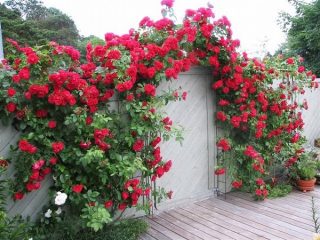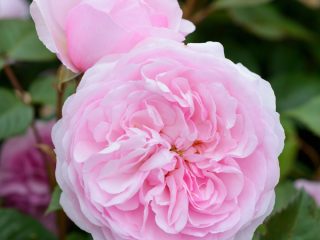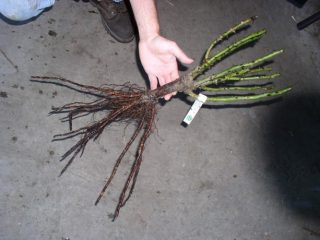Content
Scrub or bush roses were developed by breeders in the second half of the twentieth century. Since then, they have not lost popularity because they are highly decorative, winter-hardy and unpretentious. A striking representative of this group is the Paul Bocuse rose, which combines traditional flower shapes, a more advanced crown type and excellent characteristics.

Most often, in the first year after planting, the Paul Bocuse rose does not bloom.
History of selection
The park rose Guillot Paul Bocuse is the result of the work of breeders of the world famous rose garden. Its founder, Jean-Baptiste Guillot, bought a plot of land near Lyon on the banks of the Rhone in 1834, acquired several ornamental bushes from Victor Verdier and began work on developing new varieties. The nursery was named “Land of Roses”. Guillot soon became one of the leading flower suppliers in Europe.
His life's work was continued by subsequent generations, resulting in about 90 magnificent varieties.Today, roses created by the famous breeder Dominique Massad, the great-grandson of Pierre Guillot, are of particular interest. A whole series has been created based on the crossing of ancient fragrant and modern species that bloom for a long time and are resistant to adverse weather conditions. One of them is the rose Paul Bocuse, named after the famous chef. There is nothing strange in this, since the French consider cooking and floriculture to be art and treat them with equally great respect.
Description of the Paul Bocuse rose and characteristics
The bush is tall (120-180 cm), erect, highly branched. The shoots are covered with large, glossy, dark green foliage. The crown width reaches 100-140 cm. The Paul Bocuse variety is grown on a trunk, in the form of a bush, or as a climbing variety, creating reliable support for the shoots. The branches can be arranged vertically or fall gracefully, creating a fountain of buds and beautiful stems.
Paul Bocuse rose flowers are collected in inflorescences from three to twelve pieces. The blossoming buds are large, cup-shaped, densely double, each with from 50 to 80 pointed, delicate, beautifully arranged petals. The diameter of the flowers is 8-10 cm. Their shades change depending on the lighting, weather and age - at first they are peach with a bright core, later they lighten and become pale pink. Paul Bocuse acquires brighter colors during the period of re-blooming, in August, when the heat subsides and it becomes cool.
Its aroma is extremely attractive, gradually changing from melon to cherry with notes of green tea.
The variety is drought tolerant, tolerates summer heat well, and prefers sunny places. In rainy weather, the buds may lose their decorative effect a little and only partially open. Winter hardiness is average.Immunity to powdery mildew and black spot is high.
Advantages and disadvantages of the variety
The flowering of Rose Paul Bocuse is almost continuous - after the first wave at the end of June and beginning of July, a new one, no less powerful and abundant, occurs in August.

Regions with dry and hot climates are most suitable for growing Paul Bocuse roses
In addition to this advantage, the variety has other advantages:
- highly decorative;
- unusual color of buds;
- density and power of the bush;
- strong aroma;
- immunity to fungal and viral diseases;
- winter hardiness;
- drought resistance.
Among the disadvantages of the Paul Bocuse variety:
- sensitivity to increased soil acidity;
- loss of decorativeness in rainy weather;
- negative reaction to fog and dew;
- the need for shelter for the winter.
Reproduction methods
To propagate Paul Bocuse roses, one of the vegetative methods is used. The method is chosen depending on how many new seedlings need to be obtained and the condition of the mother bush.

The best time to plant a Paul Bocuse bush rose is early May.
Cuttings
During the flowering period of the rose, cuttings 5-8 cm long are cut with two or three leaves from the central part of the shoots. Before planting, they are soaked in a growth stimulator, after which they are planted in a substrate of sand and humus, buried 2 cm. Covered on top with a jar or plastic container to create a constant temperature and humidity. After rooting, the Paul Bocuse rose seedlings are grown for a year and transferred to a permanent place.
By layering
Flexible stems are selected and placed in shallow trenches, after making cuts in the bark near the buds. The shoots are secured with staples and covered with soil.The next year, they are separated from the bush, cut into pieces with roots and planted.
Overgrowth
The scions of the Paul Bocuse rose, which are at least a year old, are found and dug up. Having been transplanted to a permanent place, they are shortened by a third. In order not to cause injury to the rose bush, it is worth choosing offspring that are located as far as possible from its base.
By division
The bush is carefully dug up and divided into parts so that each has several shoots and a viable root system. After treating the cuts with charcoal, the “cuts” are planted in a permanent place.

When favorable conditions are created, shoots of the Paul Bocuse rose reach 2 m
Growing and care
To plant Paul Bocuse roses, choose a sunny place with fertile, loose, breathable soil. The optimal acidity level is 5.7-7.3 pH. If necessary, it is deoxidized with chalk, wood ash and slaked lime.
To plant, you must perform a series of sequential actions:
- Soak the root system in water for 5 hours.
- The shoots are trimmed, leaving no more than five buds on each.
- Dig holes 50 cm deep and wide.
- Create a drainage layer.
- Fill up the soil.
- Pour 3 liters of water.
- Place a seedling on top and fill the voids with soil.
- Water and mulch the tree trunk circle.
Further care consists of timely watering, fertilizing, pruning, preparation for winter, protection from diseases and pests.

The reason for the lack of flowering may be improper watering, careless pruning and too acidic soil.
Watering and fertilizing
Young seedlings of the Paul Bocuse rose need to be moistened twice a week, using up to 4 liters of water. Adult bushes are watered once every seven days, using 10 liters per plant.
Roses quickly respond to fertilizing, which they begin to apply from the second year:
- early spring - ammonium nitrate;
- during the budding period - calcium nitrate solution;
- before flowering - potassium humate;
- after its completion - potassium-phosphorus fertilizers;
- in September – calimagnesia.

Leave gaps of 2 m between bushes
Pruning and preparation for winter
For the Paul Bocuse rose, gentle pruning is carried out to remove old, damaged or diseased branches. You should cut out shoots growing inside the bush and remove wilted buds. If it is necessary to form a crown, shorten the branches by no more than ¼ of the length.
When preparing a rose for winter, the stems are gradually tilted towards the ground, the base of the bush is mounded high, and the crown is covered with spruce branches or material.
Pests and diseases
Despite the high resistance of the Paul Bocuse rose to powdery mildew, in rainy weather a white coating may appear on the leaves and branches, leading to their drying out, bending of the stems and oppression of the plant. To combat pathology, treatment is carried out with a solution of soda ash and Bordeaux mixture.
The first symptoms of rust are yellow spores on the underside of leaf blades. The diseased parts of the plant are cut out, and the rest are treated with preparations based on copper sulfate.
Black spot most often affects roses in late summer. If dark spots with a yellow border appear, they should be sprayed with Khoma solution.
Colonies of aphids and spider mites attack the buds and young shoots of roses, sucking the juice out of them and causing them to dry out.For control, folk remedies (tobacco infusion) or broad-spectrum insecticides (Fufanon, Aktara, Zubr) are used.
Application in landscape design
The park rose Paul Bocuse looks impressive in single and group plantings, regardless of location. Ground cover plants can be used as its companion. When planting bushes in one row, you get a beautiful hedge that looks especially impressive during the flowering period.
The Paul Bocuse standard rose, formed according to all the rules, looks very original. A flowering tree with one trunk seems to float above other plants if you place it in the background of a flower garden. In combination with bush forms, the trunks form compositions that create an unusual garden that gives the site individuality.
The variety looks no less advantageous together with clematis.
Conclusion
Rose Paul Bocuse is a true French beauty with abundant flowering and a beautiful shade of buds. It combines with other varieties, forms unique compositions and does not require much time for care.










